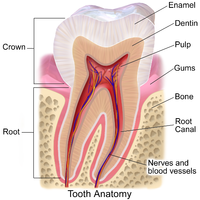
Photo from wikipedia
OBJECTIVE One of the limiting factors of employing laser radiation on dental therapies is the potential of causing thermal injuries to pulp tissues. The purpose of this study was to… Click to show full abstract
OBJECTIVE One of the limiting factors of employing laser radiation on dental therapies is the potential of causing thermal injuries to pulp tissues. The purpose of this study was to evaluate intra-chamber temperature increase on extracted human teeth exposed to 670 nm wavelength InGaAlP laser diode radiation. MATERIALS AND METHODS In vitro intra-chamber temperature measurements of 12 standardized human teeth (incisors, canines, premolars, and molars; n = 3) were taken both before and after laser radiation. A type-K thermocouple fast-response thermocouple wire with a 0.5 mm diameter probe was inserted into the tooth pulp chamber (ICEL-Manaus-brand). The laser device Lasotronic-brand InGaAlP laser diode was used to irradiate tooth enamel, perpendicularly to the external surface for 30 sec, with power of levels of 340, 272, 204, 136, and 68 mW. The measurements were taken at three time points: 0, 30 sec, and 3 min after the laser irradiation. Measurements were repeated 24 h after removal and reinsertion of the probe in the pulp chamber. The temperature gradient (ΔT in °C) was calculated (ΔT = final temperature-initial temperature) for each group. Data of ΔT were statistically analyzed by two-way analysis of variance (ANOVA) at the 95% confidence level and compared by Tukey post hoc test (α = 0.05). RESULTS ANOVA showed statistically significant differences to the interaction of factors (p < 0.05). The highest ΔT values obtained were observed to incisors with 340 mW, 272 mW; 204 mW of power (respectively 4.7°C, 4.2°C, and 3.1°C); and canines presented the lowest ΔT (0.8°C-0.3°C) with no influence of power output. CONCLUSIONS Since the thermal increase was observed in this study, especially in incisors, attention should be paid to avoid pulpal damage.
Journal Title: Photomedicine and laser surgery
Year Published: 2017
Link to full text (if available)
Share on Social Media: Sign Up to like & get
recommendations!